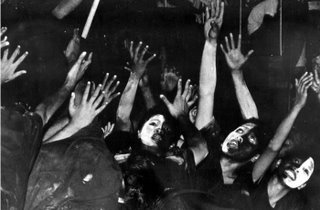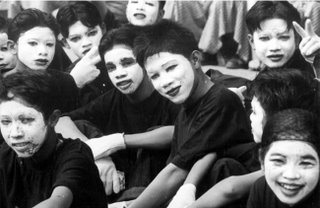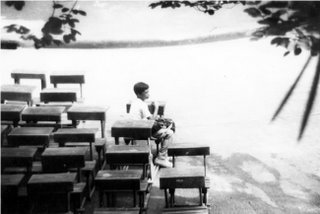No, we definitely cannot be talking about music here; I am tone deaf, you see. Tone in photography refers to the transition of light to dark within the subject of your photograph. The variations in tones provide us with the visual information enabling us to distinguish one object from another, and to determine a photograph’s quality.

The distribution and variation of light and shadow within the image set the mood of a photograph. A picture with primarily dark tones will convey a somber, dramatic, mysterious mood (as in the picture above of students with hands reaching upwards, towards something or someone).

Light tones, on the other hand, convey to the viewers a cheerful, open and optimistic mood as in this picture of cadets preparing for the fancy drill.

When bright and dark tones are both present, a bold, assertive image will be created like in this picture where the painted faces are pure white and the T-shirts are solid black.
By the way, in the climactic scene of the movie “City Hal,l” Al Pacino playing the role of New York City mayor Joe Pappas, says: “There’s black and there’s white. It’s the grays in between that give us the problems.” He was referring of course to ethics and moral standards (are there such things?) in politics. If he had been referring to black and white photography, he could not have been more wrong.

Good black and white photographs often display what photographers refer to as “full tonal range.” A good picture, in terms of tone, oftentimes exhibit solid blacks, pure whites and varying degrees of grays, like in this picture where the guy on the right obviously has a face only his mother (or Buffy the Vampire Slayer) could love. His fangs are pure white, the background on the upper left hand corner is pure black, while the bags on the foreground exhibit various shades of gray. A picture with only black and white tones would just show the subject’s shape or outline (known as a “silhouette”). The varying shades of gray (dark, light or medium) generally produce a more aesthetically pleasing image.
So you see, “there’s black and there’s white. It’s the grays in between that give us good pictures.”
Element of contrast

Closely related to tone, contrast is the difference between the strongest highlight and the darkest shadow in a photograph. When a picture uses tones at the opposite ends of the tonal range, it is said to have “high contrast.” Photographs with extremely high contrast like in the picture above will lack detail in the burned out highlights (the ground) and in the almost solid black shadows (the desks and the overhanging foliage).
“Low contrast” images on the other hand, have a limited range of tones. When the range between the highlights and the shadows is very low, the resulting pictures will look muddy and dull. Nothing is black and white as the movie “White Man’s Burden” starring John Travolta and Sidney Poitier would say.
You have to keep in mind that the eye sees the world differently from the way film does. While our eyes can distinguish tones in a scene with a brightness range of 1:1000, film can only record a very limited range of brightness. The technique is to squint your eyes while looking at your subject - this will give you a fairly good idea of how the scene will record on film.

No comments:
Post a Comment